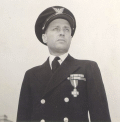
050113201 |
24k | Quentin Robert Walsh, born Providence, Rhode Island, 02 February 1910, graduated in 1933 from the U.S. Coast Guard Academy in New London, Connecticut. His first assignments were aboard the Coast Guard cutters that captured "rum runners" between Cuba and Nova Scotia. In the late 1930s, he spent a year as an observer on a whaling factory ship cruising 30,000 miles from Sweden to Australia, the Indian Ocean and Antarctica.
Walsh served on the staff of the commander of the U.S. naval forces in Europe when he helped draw up plans to seize the strategic port of Cherbourg, on the northern edge of Normandy's Cotentin Peninsula, during the planning for Operation Overlord. Possession of the deep-water port was vital to expedite shipment of the tons of cargo needed to supply invading Allied armies that would storm the Normandy beaches on D-Day, June 6, 1944.
Then-Commander Walsh's plan called for the formation of a specially trained naval reconnaissance unit to determine the condition of the port after its capture. He volunteered to lead the special mission, which after some training arrived off Utah Beach on June 9, 1944, only three days after D-Day, the day the first Allied forces hit the beaches. Captain Walsh's 53-man unit endured shelling and a storm that turned dirt roads into inches-deep paths of mud. His unit made contact with elements of the U.S. 79th Infantry Division at Cherbourg. The Allies faced off with the Germans in fierce house-to-house fighting.
The Allied forces quickly captured the eastern part of the port, while most of the Germans retreated to the western section of the city. Knowing the port was essentially unusable with pockets of resistance firing at them, Walsh personally led a 16-member unit of his special task force on a raid to an arsenal area and adjacent waterfront on the western side of the port city.
Armed with bazookas, hand grenades, rifles and submachine guns, he and his party overcame sniper fire and blew open steel doors of underground bunkers. About 400 of the Germans in the arsenal area surrendered. Walsh's command went on to capture Fort Du Homet and its garrison of 350 men. In all, his 53-man special force was credited with taking about 750 German prisoners and liberating 52 captured American paratroopers. For his actions in and around Cherbourg beginning June 9, he received the Navy Cross [see above photo]. The citation for the award noted:
"Heroism as Commanding Officer of a U.S. Naval party reconnoitering the naval facilities and naval arsenal at Cherbourg June 26 and 27, 1944. While in command of a reconnaissance party, Commander Walsh entered the port of Cherbourg and penetrated the eastern half of the city, engaging in street fighting with the enemy. He accepted the surrender and disarmed 400 of the enemy force at the naval arsenal and later received unconditional surrender of 350 enemy troops and, at the same time, released 52 captured U.S. Army paratroopers. His determination and devotion to duty were instrumental in the surrender of the last inner fortress of the Arsenal."
Captain Walsh lived in Arizona on physical disability after World War II, recovering from respiratory problems stemming from emphysema he contracted while stationed in England. He was recalled to active duty during the Korean War and served in a variety of duties at Coast Guard headquarters in Washington, including as a liaison to the Treasury Department.
He retired again on disability in 1960. Walsh, who had settled in Denton, Maryland, a small rural community in Caroline County, taught science classes at North Caroline High School there from 1960 to 1965. He then served as a Maryland parole and probation officer until retiring in 1975. He was known in Denton for his community activism to preserve its historic district. Walsh passed away 18 May 2000, and is interred in the Maryland Veterans Cemetery at Hurlock.
| Dave Wright |

